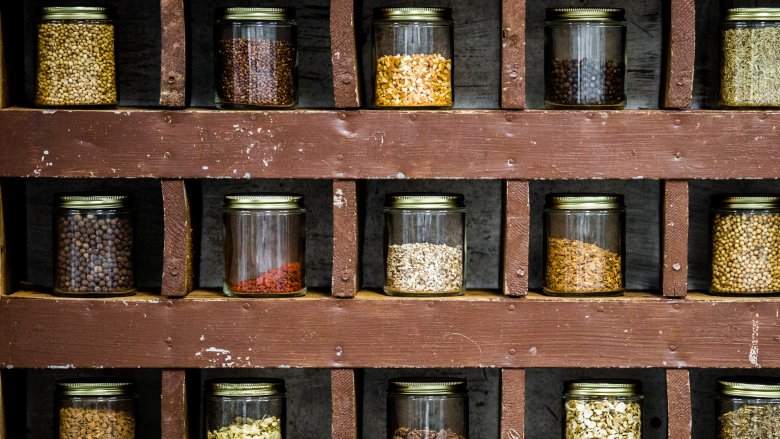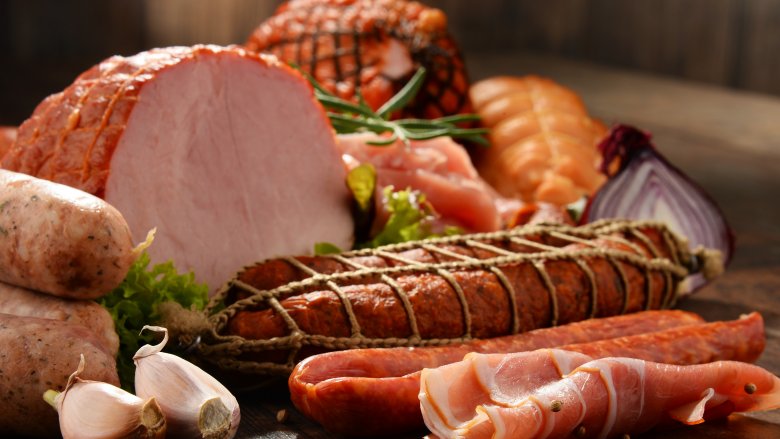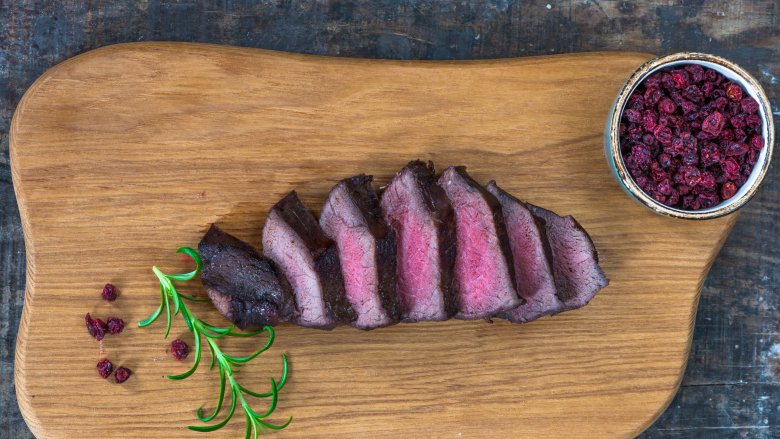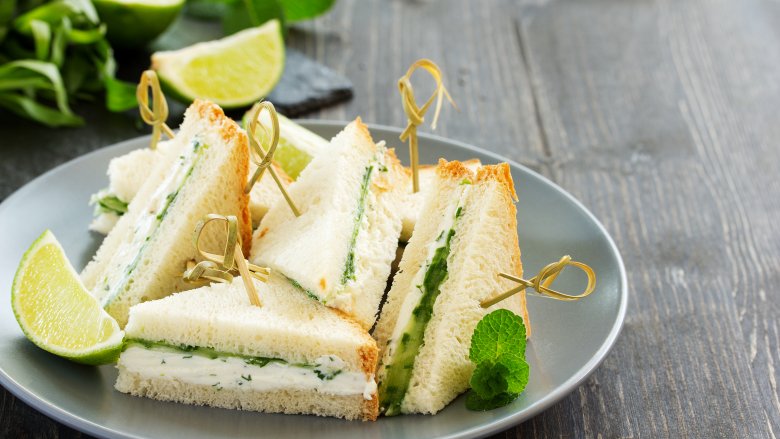Everyday Dishes Only Rich People Used To Eat
Here in the 21st century, we're living in an era of unprecedented access to food. Those of us in the developed western world can get our hands on pretty much any food from anywhere at any time, with few or no restrictions based on our location, abilities or, perhaps most importantly, our social status. That's not to say food nowadays doesn't have a social factor to it — you probably won't find meatloaf in too many Michelin restaurants, and few of us are going to be chowing down on caviar for dinner tonight — but the limitations we do face are nothing compared to what was once the case.
Over the course of history, the rich have enjoyed the privilege of being able to obtain certain special foods, whether by circumstance, by coercion or even by law. As is the nature of history, however, things change quickly, and some of the rarest and most expensive foods back then have become some of the ordinary and easily obtainable today.
Fruit
Throughout history, fruit has, in one way or another, been unobtainable by the lower classes. At one point, fruit in general was almost entirely reserved for the wealthy. In the Roman period, for example, fruit was only available to those who could afford it, and even before that it was a particularly favored type of food among wealthier Egyptians.
At other times, when fruit has been more commonly found across the social spectrum, there have still been a few prized fruits which none but the richest could acquire. In the 18th century, when global trade routes meant fruit was more easily accessible than ever, pineapple was still seen as a rare delicacy, and a single one could cost the equivalent of $8,000 today, with some socialites displaying them at parties to show off.
Ice-cream
There's a good chance you've got a tub in your freezer right now, but for most of its existence, being able to enjoy ice-cream was a very special privilege. Its predecessor, which was little more than flavored snow, was acquired by wealthy ancients at great difficulty—Nero Claudius Caesar would send servants up into the mountains to retrieve it during the Roman Empire.
Even as late as the 19th century ice-cream, then called "fancy ices," were created painstakingly by expert cooks for the enjoyment of the aristocracy, although the invention of the hand-cranked freezer and other similar advancements, including the creation of insulated ice houses, meant ice-cream was more readily available for others too, before a surge in popularity after World War II turned it into the beloved dessert we all know and love, even today.
Spices
Today, no kitchen is complete without a rack adorned with countless different herbs, spices and seasonings. In medieval times, however, spices were an exotic rarity afforded only to the privileged. Most of them came from Asia, meaning traders had to travel vast distances to acquire them. As a result, they were often extraordinarily expensive. In the 14th century, nutmeg was more valuable than gold, and even aristocrats found it difficult to afford many spices.
The wealth that could be shifted through trading spices led to the establishment of lucrative trade routes, monopolies and, eventually, empires. It's not a stretch to say that, whether you were an individual or a nation, getting hold of spices was a really, really big deal.
Meat
Although just how much you'd get (and what type it would be) was extremely variable, the consumption of meat is pretty uniform across history. Generally, both rich and poor have included it in their diets. This isn't quite true, however, with the Ancient Greeks, who fed predominantly on vegetarian foods. Only the wealthy could afford a regular diet of meat.
The Romans tended to consume more meat than the Greeks, with the poor tending towards ham, bacon and sausages, although certain meats, such as beef, lamb and finer cuts of pork, were saved exclusively for those who could afford them. Wild game, despite being relatively common today, was also seen as a hugely exotic delicacy.
Venison
For much of English history, meat of some sort was widely available to lords, peasants, gentry and kings alike. The biggest exception was venison. After the Norman Conquest in 1066, whole tracts of land in England were granted royal status under forest law, meaning that only the king and his invited entourage was allowed to hunt in them. The "beasts of the forest," which included deer, became property of the crown. These laws were kept for hundreds of years, meaning venison was only available to the king, whoever was lucky enough to dine at court, certain landowners and the braver poachers. Today, venison can be found in the freezers of most hobby hunters and at some grocery stores. It's still more expensive than many meats, but at least you won't get fined (or worse) for eating it.
Fish
At some points in history, fish has been a food for all — a law was even introduced by Elizabeth I in 1564 to force people to eat it on certain days of the week — but that hasn't always been the case. Fish was seen as a luxury in Ancient Greece, despite being a Mediterranean culture, and a class system grew around it. In Rome, too, fresh fish was hugely expensive because of the city's distance from the coast, although salted fish was more common among the poor. Even just before Elizabeth I's time, when fish was widely available, a menu for Henry VIII demonstrated that certain types, such as salmon, haddock and trout, were seen as exclusive to the rich.
Sandwiches
The sandwich, in its current form, was invented by John Montagu, the Earl of Sandwich, who, in the 18th century, was said to have created it as a way to eat with one hand without having to stop gambling, though kinder accounts suggest it was made so that he could eat while working.
While sandwiches as we know them today might have been enjoyed by everyone, there is one particular type that was enjoyed exclusively by the upper class: the cucumber sandwich. Invented by British military officers stationed in India in the 19th century, they quickly became popular among the British aristocracy, who ate them with their afternoon tea. By the end of the 19th century, they were associated with "reckless extravagance." While the ingredients weren't exactly out of reach for the rest of society, the lightness and lack of protein meant that it wasn't nutritionally viable as a dish, and constituted something only the wealthy had the energy to spend on.
In the early 20th century, the sandwich was popularized in America with the invention of sliced bread. Today, Americans consume 45 billion sandwiches a year. Quite a way to go from one aristocrat and his gambling buddies.
Salt
Salt may be a staple part of the modern diet, and a seasoning that's included in pretty much every form of processed and pre-prepared food, but in the medieval period it was far, far harder to get. During feasts and banquets, the salt would be contained in a salt cellar and placed near the higher end of the table — where the wealthy ate — so that those who ought to be able to eat it could, and those who shouldn't... couldn't. This practice gave rise to the expression "above the salt," which even today is used to describe somebody of high social standing.
Sparkling wine
If you're lucky, you should be able to go out now and find a decent bottle of sparkling wine for under $10. Thanks to the supermarket economy, some Champagnes can even be just as cheap, but even sparkling wine's place of relative prestige when placed against most other wines does little justice to the esteem in which it was once held.
Champagne, of course, was the first. After its creation by Dom Perignon in the 17th century, it became the favored drink of the French monarchy, being served at coronations and eventually becoming fashionable among aristocrats around Europe. Arguably, the entire sparkling wine industry was built on the tastes of the European aristocracy. During the early 20th century, however, consumption of Champagne spread beyond the nobility, and, after 1945, it began to reach other social circles. Imitators soon appeared, and now sparkling wine is as commonplace outside the aristocracy as any other wine — even if it's a little more expensive.









